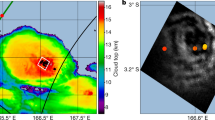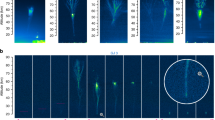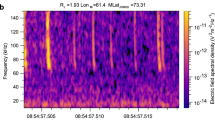Abstract
For over a century, numerous undocumented reports have appeared about unusual large-scale luminous phenomena above thunderclouds1,2,3,4,5,6 and, more than 80 years ago, it was suggested that an electrical discharge could bridge the gap between a thundercloud and the upper atmosphere7,8. Since then, two classes of vertically extensive optical flashes above thunderclouds have been identified—sprites9,10,11 and blue jets12,13,14. Sprites initiate near the base of the ionosphere, develop very rapidly downwards at speeds which can exceed 107 m s-1 (ref. 15), and assume many different geometrical forms16,17,18,19. In contrast, blue jets develop upwards from cloud tops at speeds of the order of 105 m s-1 and are characterized by a blue conical shape12,13,14. But no experimental data related to sprites or blue jets have been reported which conclusively indicate that they establish a direct path of electrical contact between a thundercloud and the lower ionosphere. Here we report a video recording of a blue jet propagating upwards from a thundercloud to an altitude of about 70 km, taken at the Arecibo Observatory, Puerto Rico. Above an altitude of 42 km—normally the upper limit for blue jets and the lower terminal altitude for sprites—the flash exhibited some features normally observed in sprites. As we observed this phenomenon above a relatively small thunderstorm cell, we speculate that it may be common and therefore represent an unaccounted for component of the global electric circuit.
This is a preview of subscription content, access via your institution
Access options
Subscribe to this journal
Receive 51 print issues and online access
$199.00 per year
only $3.90 per issue
Buy this article
- Purchase on Springer Link
- Instant access to full article PDF
Prices may be subject to local taxes which are calculated during checkout


Similar content being viewed by others
References
Wood, C. A. Unusual lightning. Weather 6, 64 (1951).
Wright, J. B. A thunderstorm in the tropics. Weather 6, 230 (1951).
Vaughan, O. H. Jr & Vonnegut, B. Lightning to the ionosphere? Weatherwise 70–72 (April, 1982).
Vaughan, O. H. Jr & Vonnegut, B. Recent observations of lightning discharges from the top of a thunderstorm into the clear air above. J. Geophys. Res. 94, 13179–13182 (1989).
Hammerstrom, J. G. Mystery lightning. Aviat. Week Space Technol. (30 August, 1993).
Rodger, C. J. Red sprites, upward lightning, and VLF perturbations. Rev. Geophys. 37, 317–336 (1999).
Wilson, C. T. R. The electric field of a thundercloud and some of its effects. Proc. Phys. Soc. Lond. 37, 32D–37D (1925).
Wilson, C. T. R. A theory of thundercloud electricity. Proc. R. Soc. Lond. A 236, 297–317 (1956).
Franz, R. C., Nemzek, R. J. & Winckler, J. R. Television image of a large upward electrical discharge above a thunderstorm system. Science 249, 48–51 (1990).
Sentman, D. D., Wescott, E. M., Osborne, D. L., Hampton, D. L. & Heavner, M. J. Preliminary results from the Sprites94 campaign: Red Sprites. Geophys. Res. Lett. 22, 1205–1209 (1995).
Lyons, W. A. Sprite observations above the U.S. high plains in relation to their parent thunderstorm systems. J. Geophys. Res. 101, 29641–29652 (1996).
Wescott, E. M., Sentman, D. D., Osborne, D. L., Hampton, D. L. & Heavner, M. J. Preliminary results from the sprites 94 aircraft campaign: 2. Blue jets. Geophys. Res. Lett. 22, 1209–1213 (1995).
Wescott, E. M., Sentman, D. D., Heavner, M. J., Hampton, D. L. & Vaughan, O. H. Jr Blue jets: Their relationship to lightning and very large hailfall, and their physical mechanisms for their production. J. Atmos. Solar-Terr. Phys. 60, 713–724 (1998).
Wescott, E. M. et al. New evidence for the brightness and ionization of blue starters and blue jets. J. Geophys. Res. 106, 21549–21554 (2001).
Stanley, M. et al. High speed video of initial sprite development. Geophys. Res. Lett. 26, 3201–3204 (1999).
Gerken, E. A., Inan, U. S & Barrington-Leigh, C. P. Telescopic imaging of sprites. Geophys. Res. Lett. 27, 2637–2640 (2000).
Stenbaek-Nielsen, H. C., Moudry, D. R., Wescott, E. M., Sentman, D. D. & Sao Sabbas, F. T. Sprites and possible mesospheric effects. Geophys. Res. Lett. 27, 3827–3831 (2000).
Heavner, M. J. Optical Spectroscopic Observations of Sprites, Blue Jets, and Elves: Inferred Microphysical Processes and their Macrophysical Implications. Thesis, Univ. Alaska (2000).
Moudry, D. R., Stenbaek-Nielsen, H. C., Sentman, D. D. and Wescott, E. M. in Abstr. National Radio Science Meeting of URSI G/H3-12, 107 (Boulder, Colorado, 2001).
Uman, M. A. The Lightning Discharge (Academic, San Diego, 1987).
Petrov, N. I. & Petrova, G. N. Physical mechanisms for the development of lightning discharges between a thundercloud and the ionosphere. Tech. Phys. 44, 472–475 (1999).
Pasko, V. P., Inan, U. S. & Bell, T. F. Large scale modeling of sprites and blue jets. Eos 80, F218 (1999).
Pasko, V. P. & George, J. J. Three-dimensional modeling of blue jets and blue starters. Eos 82, F150 (2001).
Hale, L. C., Croskey, C. L. & Mitchell, J. D. Measurements of middle-atmosphere electric fields and associated electrical conductivities. Geophys. Res. Lett. 8, 927–930 (1981).
Croskey, C. L., Hale, L. C. & Mitchell, J. D. Electrical stratification in the middle atmosphere. Adv. Space Res. 10, 49–52 (1990).
Lyons, W. A., Stanley, M. A., Nelson, T. E. & Taylor, M. Sprites, elves, halos, trolls and blue starters above the STEPS Domain. Eos 81, F131 (2000).
Wescott, E. M. et al. Starters: Brief upward discharges from an intense Arkansas thunderstorm. Geophys. Res. Lett. 23, 2153–2156 (1996).
Sukhorukov, A. I., Mishin, E. V., Stubbe, P. & Rycroft, M. J. On blue jet dynamics. Geophys. Res. Lett. 23, 1625–1628 (1996).
Roble, R. G. On modeling component processes in the Earth's global electric circuit. J. Atmos. Terr. Phys. 53, 831–847 (1991).
Rycroft, M. J., Israelsson, S. & Price, C. The global atmospheric electric circuit, solar activity and climate change. J. Atmos. Solar-Terr. Phys. 62, 1563–1576 (2000).
Acknowledgements
The GEN III intensifier was provided by ITT Night Vision Industries; we thank M. Robinson for support of our work. We thank W. Lyons for discussions, and S. Gonzalez, Q. Zhou, M. Sulzer, C. Tepley, J. Friedman, E. Robles, A. Venkataraman and E. Castro for support of our observations at Arecibo Observatory. The Arecibo Observatory is a component of the National Astronomy and Ionosphere Center, which is operated by Cornell University under a cooperative agreement with the National Science Foundation. This work was supported by a Small Grant for Exploratory Research from the National Science Foundation to Pennsylvania State University. Stanford participation was also supported by the Office of Polar Programs of the National Science Foundation.
Author information
Authors and Affiliations
Corresponding authors
Ethics declarations
Competing interests
The authors declare no competing financial interests.
Rights and permissions
About this article
Cite this article
Pasko, V., Stanley, M., Mathews, J. et al. Electrical discharge from a thundercloud top to the lower ionosphere. Nature 416, 152–154 (2002). https://doi.org/10.1038/416152a
Received:
Accepted:
Issue Date:
DOI: https://doi.org/10.1038/416152a
This article is cited by
-
Optical observations of thunderstorms from the International Space Station: recent results and perspectives
npj Microgravity (2023)
-
Spectroscopy of a mesospheric ghost reveals iron emissions
Nature Communications (2023)
-
An assessment of whistlers generated from tree-like gigantic jets
Terrestrial, Atmospheric and Oceanic Sciences (2023)
-
Similarity theory and scaling laws for low-temperature plasma discharges: a comprehensive review
Reviews of Modern Plasma Physics (2023)
-
Quantification of surface charging memory effect in ionization wave dynamics
Scientific Reports (2022)
Comments
By submitting a comment you agree to abide by our Terms and Community Guidelines. If you find something abusive or that does not comply with our terms or guidelines please flag it as inappropriate.



